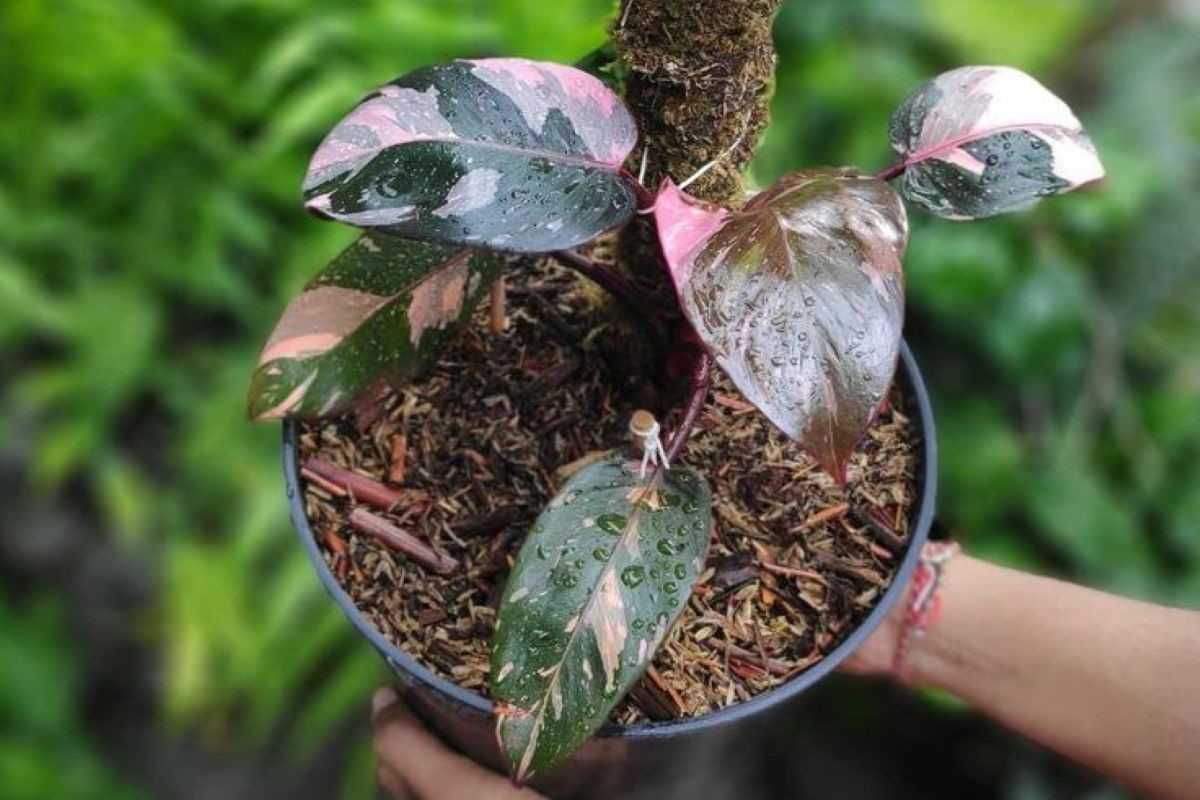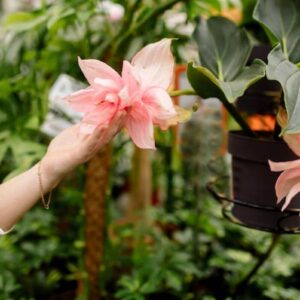
Pink Princess Philodendron is a renowned tropical plant with heart-shaped leaves that genuinely deserve attention and is cherished by plant enthusiasts. A covetable gem to plant parents who love the pop of color, its stunning deep emerald green is considered a treasure for plant keepers.
Also known as PPP to plant collectors, this low-maintenance, stunning houseplant is a visual gratification. It is essential to adhere to a consistent care routine for these plants, to maintain a vibrant pink color.
Pink Princess Philodendron needs high maintenance, and care routine to grow enthusiastically, any negligence might lead to the destruction of the plant. A scheduled routine is necessary to ensure the pink hue.
Let’s discover expert tips that can be implemented to maintain routine and learn how to care for Pink Princess Philodendron like a pro below. Some governing factors should be weighed for maintenance.
Pink Princess Philodendron: An In-depth Look
The Pink Princess Philodendron is a stunning plant famous for its dark Green heart-shaped resemblance to leaves adorned with bright pink variegation, which mostly takes the form of splashes, streaks, or even entire leaves, radiating a striking contrast that turns each plant distinctively beautiful and highly desired by plants enthusiast.
1. Native:
The pink princess plants originated from the tropical regions of America and the Caribbean, thriving in the warm and humid climates of rainforests. They belong to the Arum family (Araceae), which also includes plants like Zantedeschia (Calla Lily), Caladium (Angel Wing), Monstera (Swiss Cheese Plant), and Colocasia (Elephant Ear).
2. Size:
As long as the plant is supported, the plant can reach a height of 3-4 feet (90-120 cm) and a spread of 1-2 feet (30-60 cm). In optimal settings, its growth can be vigorous.
3. Foliage:
This plant showcases glossy, heart-shaped dark green leaves approximately 8 inches (20 cm) long, stunningly variegated in shades orbiting from blush to deep. Each leaf is distinct, showcasing variegation in different patterns, including splashes, spots, and valiant contrast.
4. Benefits:
- Improve the quality of Air
- Creates aesthetic appeal
- Enhance the quality of the surrounding environment
5. Uses:
- Pink Princess Philodendron is mainly used as a decorative plant
- Gives a stunning appearance
- Adds colors to any indoor plant collection
- Often used as a statement in your interior design
Pink Princess Philodendron Care

Originating from South America, especially (Columbia), the Pink Princess Philodendron’s unusual coloration is hidden until its leaves unfold. This aroid plant in the Araceae is renowned for its pink splashes. It’s easy to grow if a scheduled care routine is implemented and if you maintain the proper water, light, soil, and humidity.
1. Water:
The basic need of every living creature. Only water your Pink Princess Philodendron when the top half of the soil looks dry and rough. Before watering your plant, touch the soil surface, if it looks or feels dry to you and falls off your hand, it’s a sign that water needs to be poured.
In normal and cooler temperatures water Pink Princess every one or two weeks, in warmer weather, you’ll likely need to water the plant more often. Due to its drought-tolerant nature, PPP is vulnerable to overwatering.
2. Soil:
The type of soil plays a crucial role in growing PPP, this plant grows best in nutrient-rich, well-draining soil. Like most aroid plants, it possesses aerial roots that quest moisture.
The integration of peat, perlite, and either bark and moss radiates an ideal source for your Pink Philodendron.
3. Light:
Light is an essential element in the growth of plants, as the process of photosynthesis happens in the presence of light. Without the proper amount of light, pink philodendron leaves fade and turn green. To prevent this, find a space in your home that receives bright, and indirect sunlight.
If your home doesn’t get enough bright light, using a grow light is crucial to maintaining the Pink Philodendron looking as stunning as the day you brought it.
4. Humidity And Temperature:
Maintaining the proper temperature for PPP is necessary for better growth and looks of plants.
As with other tropical plants, the pink princess philodendron prefers a moist, warm environment. The recommended temperature is below 6 degrees Fahrenheit or above 79 degrees.
5. Propagation
The Pink Princess Philodendron is a rare and expensive plant, so propagating it is a great way to increase your collection. Opt for water propagation as the simplest way to grow a new plant from stem-cutting.
Cut below the leaf and several nodes, and immerse the cutting in a container of water, ensuring the nodes are submerged. Once the roots reach approximately an inch in length, then transfer the cutting to the soil.
Relocate Pink Princess Philodendron
It may look tempting while transferring a plant into a new pot, but you should repot it only once a year. Wait for approximately one month after bringing your plant home giving it time to acclimate before considering repotting to avoid stressing it out.
Plants should be repotted only when they outgrow their current container, usually by pulling the roots from the drainage hole.
Some Common Issues With Pink Princess Philodendron
1- Pests:
A pest attack on any plant is most likely to happen when proper maintenance is not implemented. Philodendrons are often targeted by typical pests, like Aphids, mealybugs, mites, spiders, and fungus gnats. The best treatment for avoiding such attacks is using neem oil for plants, and other natural methods to address such concerns.
2- Leaves Are Not Pink:
It is an ideal condition when the leaves of Philodendrons stay pink, but their variegation can fluctuate due to changes in light and humidity. If there’s too much light, the leaves turn brown, while lack of light may cause them to revert to green.
3- Brown Spots On Leaves:
Lack of maintenance may lead to brown spots on leaves, which indicate excessive sunlight exposure. Consider repotting it to a new place with less direct sunlight. Ensure that you are not overwatering the plant, it can lead the plant to be targeted with fungal disease.
What Is The Price Of A Pink Princess Philodendron?
Due to its rarity, it stands around $30 for a small plant. The bigger it grows the price also fluctuates. Occasionally, the price ranges from $500 to $2,000, especially after interest in plants increased in 2021. Plant size and height determine the price primarily.
Frequently Asked Questions
Q1. Is Philodendron hard to care for?
Ans: It is relatively easy to maintain, even though Pink Princess Philodendron can cost a lot. The amount of light received by the plant is what determines the level of variegation displayed by this striking plant.
Q2. Why is Philodendron Pink Princess expensive?
Ans: The cost of Pink Prince Philodendron is dependent on its rarity this stunning tropical plant has exploded in popularity due to its foliage, making it hard for growers to keep up with demand.
Q3. Can a pink princess live in water?
Ans: It is a famous plant as it can live in water and grow genuinely. It is crucial to keep soil-bound individuals wet but not soaked. Feel the surface, if it is dry add extra water to the top half.
Q4- What are the key details of Pink Princess Philodendron?
Ans: The following are some key details about this beautiful plant:
| Botanical Name | Philodendron erubescens ‘Pink Princess’ |
| Common Name | Philodendron Pink Princess, Blushing Philodendron |
| Plant Type | Perennial |
| Family | Araceae |
| Bloom Time | Spring, summer |
| Flower Color | Green, white |
| Mature Size | 4-5 ft. tall, 2-4 ft. wide |
| Sun Exposure | Partial |
| Soil Type | Loamy, moist but well-draining |
| Soil pH | Acidic |
| Hardiness Zones | 9a – 11b (US |
| Native Area | South America |






